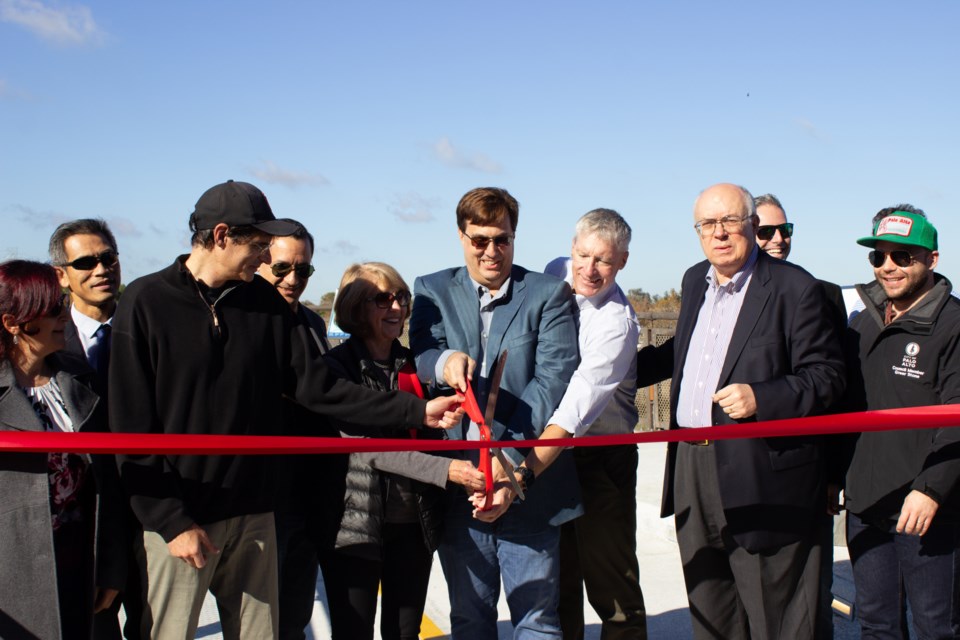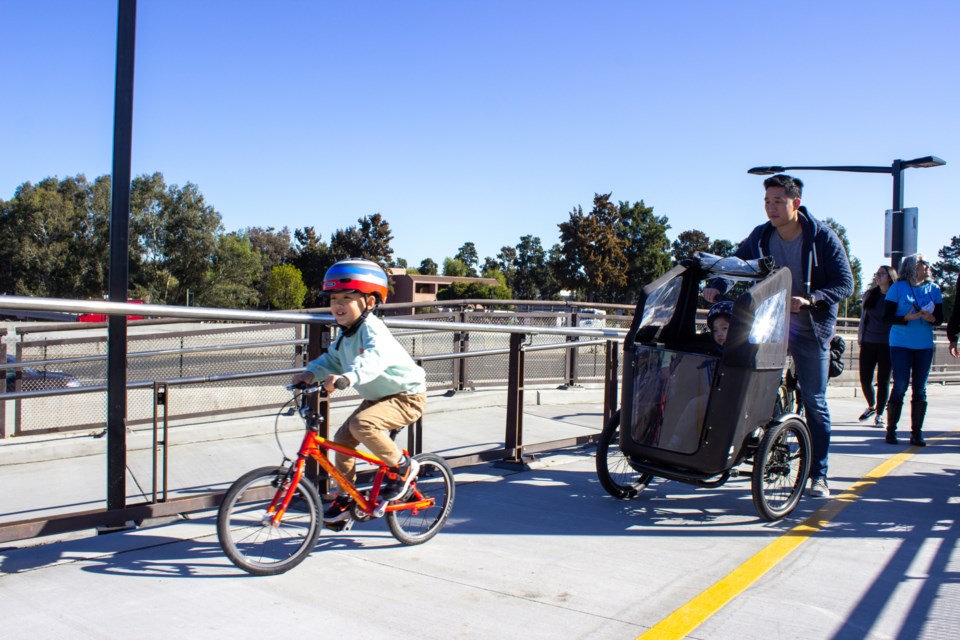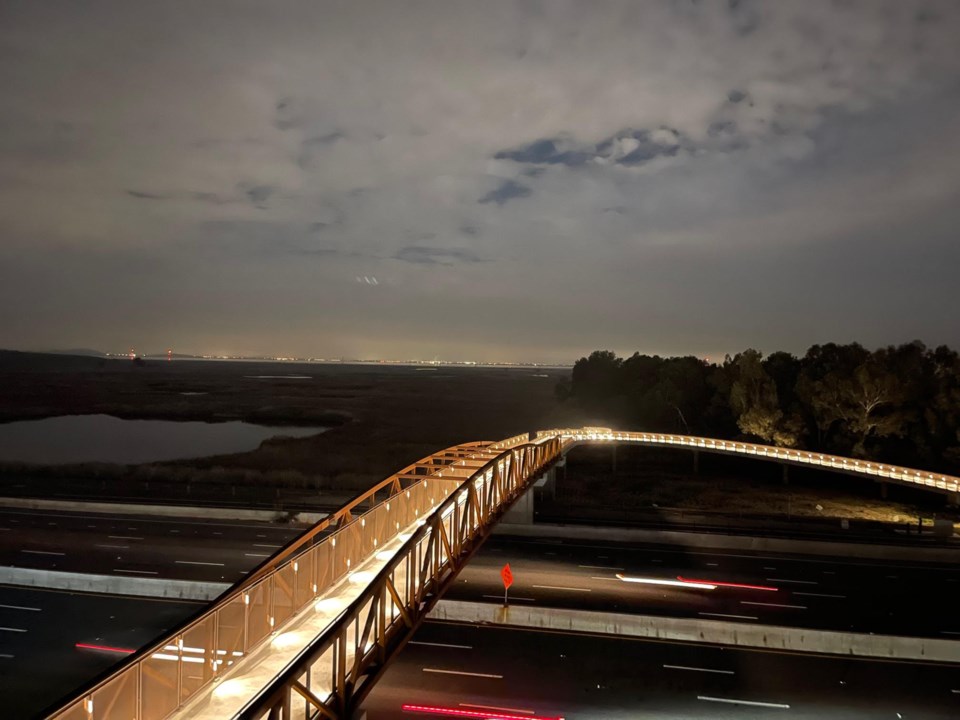|
Getting your Trinity Audio player ready...
|
"After a year and a half of construction that included 13 million pounds of concrete, 1 million pounds of structural steel and 7,000 feet of electrical and fiber optic cable … we can definitely say now that the bridge is tangible and real," Palo Alto Public Works director Brad Eggleston said.
The new overpass that will provide year-round access to the Baylands, the new Adobe Reach trail and other outdoor amenities opened Saturday to a crowd of pedestrians and cyclists just a day after construction and cleanup were completed.
Spanning 1,400 feet long between the West and East Bayshore Road landings with a 12-foot-wide pathway, the bridge replaces the Benjamin Lefkowitz underpass, which was only open six months a year, on average, due to seasonal flooding.
"I've been looking forward to this since last year," said Jeff Shusterman, a Mountain View resident and longtime cyclist who brought his bike for the occasion.
That anticipation was tenfold for the former and current city council members who came, including former Mayor Liz Kniss and Alison Cormack, to witness the city's decadelong work finally come to fruition.
In his speech, Mayor Tom Dubois recognized that many years went into planning and gathering the funds so much so that the bridge has gone through a few City Council transitions, he noted.
"We actually approved this four years ago, next week, when we finally gave it the final go-ahead," Dubois said Saturday. "That was back when we had nine council members."

For Eggleston, he recalled when Kniss, a strong proponent of the project at the time she was mayor, once dubbed the overpass the "mythical bridge."
State Sen. Josh Becker, D-Menlo Park, and Santa Clara County Supervisor Joe Simitian also shared their own anecdotes that, in jest, poked at the 10-year timeline for the bridge. Simitian proposed to extend the timeframe 10 more years since the county provided a $5.5 million grant from its Stanford Recreation Mitigation Fund that dates back to the year 2000.
"You've heard this described as a 10-year effort in the making," Simitian said. "What I would say is that it's actually a 20-year effort in the making because those mitigation funds go all the way back to the year 2000, and they were set aside for a then not yet determined purpose."
The final price tag of the bridge was $23.1 million, which became a sore point for some residents and the Weekly's editorial board. Funding came from several sources, including a $1 million grant from Google and a $4.35 million investment the city is expected to receive from the Metropolitan Transportation Commission's One Bay Area Grant Program.

Along with the higher-than-anticipated costs, some residents also began to view the bridge as yet another emblem of the bureaucratic nightmare many developers have come to expect in Palo Alto. In 2015, the city scrapped a design by Moffatt and Nichol and eventually ended up with a new firm, Biggs Cardosa Associates Inc.
Some of those frustrations may be palpable even for Megha Bansal, the city's senior engineer since 2015 and the project manager of the bridge. Most recently, she had to deal with the construction delays stemming from material transport issues and supply shortages due to the pandemic.
"Before COVID, the only thing we did was the removal of vegetation," she said.
But Bansal also elucidated that the overpass came with many constraints beyond the city's since it touched upon multiple jurisdictions. That point was made clear just by the ceremony's attendees on Saturday. Representatives from the county, CalTrans, Santa Clara Valley Water District, Valley Transportation Authority and even employees from Google made an appearance since part of the construction fell on the company's property.
"There were all these requirements from all the agencies," she said. "It was a multijurisdictional process."
During broad daylight, the bridge's most distinctive feature is the rust-brown steel trusses above the highway and Adobe Creek. According to Roy Schanbel, managing principal at Biggs Cardosa, the color can be attributed to the self-weathering steel. The material is intended to rust over time, he said, so that a protective coating is created and prevents the bridge from further rusting.
"It's supposed to look like that and it's supposed to rust," Schanbel said. "It's earthy."

But at night, the frame of the bridge blends into the night sky and mostly appears as a crisscross of faint, dotted lights. Eggleston said that LED lights were installed in a way to reduce the amount of light pollution and avoid disturbing the surrounding wildlife. Throughout the walkway, for example, the LED lights are pointed downward so that they will only serve to light up a pedestrian or cyclist's path and nowhere else, Eggleston said.
The overpass will be a convenient access point for south Palo Altans, but its use will certainly extend to residents throughout the Bay Area. Multiple cycling groups including Bike Palo Alto, Western Wheelers Bicycle Club and Silicon Valley Bicycle Coalition, whose memberships span across the Midpeninsula and south bay, came to witness the opening Saturday.
Diana Crumedy, a member of the Silicon Valley Bicycle Coalition and a San Jose resident, described how it's always a mental feat to "retrain" the mind to not be afraid of passing cars after participating in bike marathons with blocked-off roads or having protected bike lanes. But with the new bridge, she and many other cyclists from San Jose will have a safe route to look forward to in Palo Alto.
"This is the opportunity for people to have that same experience to feel that safety of being able to ride their bike without being concerned with being hit by a car," Crumedy said.
With the fanfare of the opening ceremony, which also came with free ice cream, the bridge became packed with pedestrians. Many cyclists had to resort to walking their bikes. Robert Neff, chair of the Palo Alto Pedestrian and Bicycle Advisory Committee, said the real test will be July 4, after the fireworks show in Mountain View.
But as the afternoon approached and the crowds died down, the bridge became a serene destination for pedestrians to take in the view of the Baylands and for cyclists to swiftly cross the highway.
A toddler on his bicycle led the way for his family including the dad who rode his bike with his daughter in the front carriage as he made his way up the access ramp, going west to east. Even Cormack took advantage of the bridge that Saturday, riding her bike down the bridge with glee, east to west.




